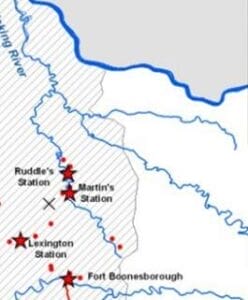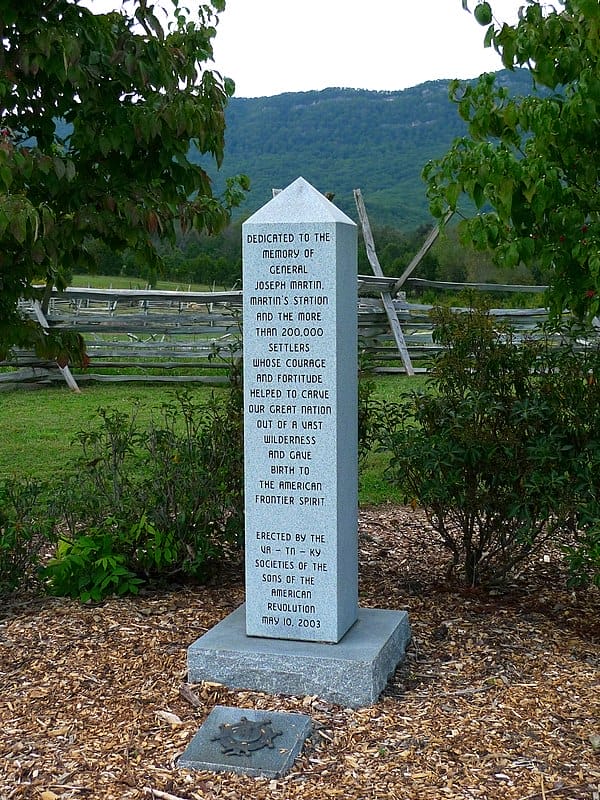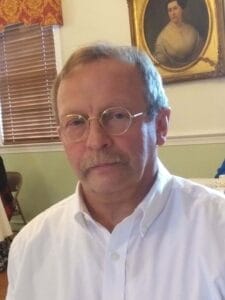
As a youth, Joseph Martin ran off from an apprenticeship during the French and Indian War of 1756, and joined the army at Fort Pitt. After his early army service, Martin headed to the frontier, where dressed in buckskin, he became a real estate speculator, trapper, fur trader and Indian fighter. Martin also gained 20,000 acres of land from Patrick Henry in a surveying contest at Powell Valley. Eventually the soldiering, trapping and Indian fighting transformed the young Martin into a fearsome explorer.
As a young adult, Joseph Jr’s favorite activity was gambling. He sometimes pretended to over-drink so he might appear to be drunk in order that fellow gamblers would let down their guard.

Martin’s Station stood along the Wilderness Trail near Rose Hill, Virginia. Martin arrived in Powell Valley in 1769, having been offered a grant by Dr. Thomas Walker of 21,000 acres. Martin constructed “improvements” upon the land, that being a few cabins and a corn planting, but Martin’s party was attacked by the local Native Americans.
He returned a few years later in 1775 and built a new “Martin’s station”. At this time he was serving as Richard Henderson’s land agent/representative. Again he was attacked by the Indians and had to leave.
Moving closer to the Cumberland Gap, he built another new “Martin’s Station”, his third, in 1783. The small fort provided protection plus supplies for hunters and immigrant families moving into Kentucky. He was able to finally sell his fort and lands in Powell County, Kentucky in 1788, and moved back to the town in Henry County, Virginia.
On November 3, 1777, Martin was commissioned by Governor Patrick Henry as Agent and Superintendent for Indian Affairs for the State of Virginia. (Martin served in the same capacity with the state of North Carolina from 1783 to 1789). Martin held the appointment until 1789.
During the Revolutionary War, Martin that helped prevent the Overhill Cherokee from launching widespread attacks on American colonists, driven by Loyalist agents. Martin’s diplomacy with the Cherokees in 1780–81, also helped the Continental Army to achieve victory over the English at the Battle of Kings Mountain..
From 1784 to 1793 Martin represented his district in the general assembly, and in 1793 he was made a brigadier general of state militia. Martin was described as a brawny man, more than six feet tall and the father of 18 children; wore buckled knee breeches and a great beard, braided and thrust inside his shirt.
Martin first married Sarah Lucas in Orange County, Virginia. After her death in Henry County, Martin married Susannah Graves, of Spotsylvania County, Virginia. Martin was simultaneously married to his half-Cherokee wife, Elizabeth Ward, the daughter of Nancy Ward, a power within the Cherokee tribes. The polygamous relationship, justified by Martin as common practice among frontiersmen operating among the tribes, caused his offspring some frustration.
By the end of the Revolution, Martin’s place as chief colonial Indian agent seemed secure. In January 1780, Virginia governor Thomas Jefferson directed Martin to negotiate with the Cherokees to secure land around a new fort being overseen by General George Rogers Clark at the mouth of the Ohio River (Fort Jefferson). In the fall of 1783, the State of Virginia built a new fort at the Cumberland Gap, replacing an older fort which was adjudged to lie within the boundaries of North Carolina. The new Virginia fort was designed as the primary residence for Martin while he was in the region on official business.
Some felt Martin was seen as too lenient with the Indians, especially after an incident in 1786 when several young Cherokee warriors were said to have murdered two white settlers near Clinch Mountain. “Partisans of the State in North Carolina afterwards found him obnoxious to their views,” former Governor Henry wrote Virginia Senator William Grayson in urging Martin’s reappointment in 1789.
Ultimately, General Martin lost his appointment as chief Indian agent. Martin’s “manner of treating with the Indians necessarily prevented his appointment,” Senator Richard Henry Lee informed Patrick Henry in September 1789. “At present no such office as a standing Indian agent is appointed. The Government of the Western Territory is charged with such affairs.”
During his colorful and busy life on the frontier, Martin was also called upon to serve served as a member of the North Carolina Convention called to approve the United States Constitution, and served several times in the North Carolina General Assembly. Martin was subsequently elected to the Virginia House of Delegates, until he finally chose to retire because of advanced age.
General Joseph Martin died at his “Belmont” farm in Henry County, Virginia, in 1808, and was buried in the family cemetery at Greenwood plantation.
Sources:
Wikipedia
The Kentucky Encyclopedia
The Tennessee Encyclopedia
founderoftheday.com
hopewellmuseum.org
jstor.org
Josephmartinchapter.org
Welcome to “Sharing the Stories of History with Tim Mann”!
Meet Timothy A. Mann, a passionate historian born and raised in the heart of Shelby County, Ohio where Tim’s roots run deep in the rich soil of American history. As the author of articles and books, including “Frontier Miscellany Concerning the Miami County Ohio Militia,” “Colonel John Mann, His Kith and Kin,” and “Frontier Militia – The War of 1812,” Tim’s literary contributions have enlightened and inspired countless history enthusiasts.
Join Tim Mann on a journey through time as he shares fascinating tales, untold stories, and hidden gems from the annals of history. Let’s delve into the past together and uncover the wonders that await in “Sharing the Stories of History with Tim Mann.”




